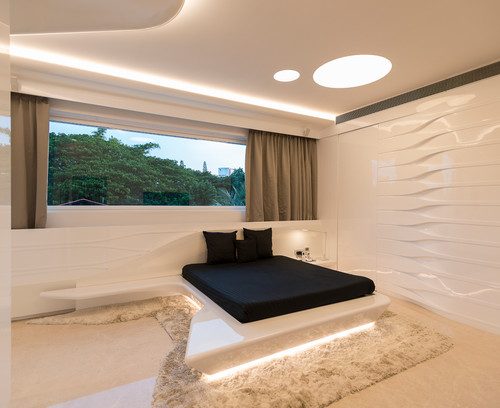5 Key Surface Finishing
Materials - Pros and Cons!
Surface finishing materials in innumerable designs and
patterns abound today. Choosing the right material that best suits a design
concept and specific needs of a space is extremely important.
Today we look at a few materials, their uses, advantages
and disadvantages.
·
Laminates
A vital surfacing material, Laminates
are made from layers of decorative Kraft-paper glued together under high
pressure and temperatures and then treated with melamine and phenolic resins. Available
in sheet sizes of 8’x4’ in thickness of 0.5mm to 1.5mm.
Pros
-
Cost effective and durable, they can be
used both on horizontal and vertical surfaces for all types of furniture units.
-
Being available in a variety of
colours, textures and patterns makes it a versatile material for varied themes.
-
Easy maintenance, as it can be cleaned
with a moist cloth.
Cons
-
Non heat resistant, this material has
to be handled carefully when used as countertop materials.
-
Gloss and High Gloss options are not
entirely scratch proof.
-
Non Uni-Core laminate edges are
unappealing as their black core is exposed.
·
Veneer
Veneers are thin slices of good quality hardwood glued onto a core
sheet of plywood or Mdf board. Available in sheet sizes of 8’x4’ in thickness
of 1.2mm to 1.35mm.
Pros
-
A very small amount of good quality
hardwood Veneer can achieve the look of solid wood making it a sustainable
option.
-
Warping, splitting and cracking
associated with solid wood can be avoided when Veneers are used.
-
Veneers are more readily available and
a less expensive option when compared to solid wood.
Cons
-
Veneer work requires skill, making it
expensive.
-
Highly susceptible to damage from
water, it has to be given a protective layer in the form of Melamine or a
Varnish finish.
-
Repairs have to be handled carefully,
as increased sanding to rectify any errors can remove the thin wood layer and
expose basic core beneath.
·
Acrylic Laminates
Acrylic Laminate is a light weight, non-toxic, reflective, high
gloss premium finish. Available in sheet sizes of 8’x4’ in thickness of 1mm to
8mm.
Pros
-
Available in a wide range of solid colours
in glossy finish, they enhance the visual appeal of the space it is used in.
-
Colour and brightness of the material
is retained for many years.
-
Scratch resistant Acrylics are user
friendly as they do not tarnish easily.
Cons
-
High maintenance since its glossy
surface requires regular cleaning as finger prints and stains are easily
visible.
-
Expensive option that can be used only
in select spaces.
·
PVC Sheets
Poly Vinyl Chloride is a hybrid material made of polymer fibres and
additives. Available in sheet sizes of 8’x4’ in thickness of 1mm to 4mm.
Pros
-
Available in solid colours, patterns
and wood prints, both in matt and glossy finish.
-
Material can be bent at 90deg, allowing
a seamless finish at the edges.
-
Being Water and termite proof makes
this a versatile material that can be used in humid climate.
Cons
-
Skilled labour is required to deliver
the bend required to cover edges.
-
Certain boards of lesser thickness are
prone to cracks during bending process and a guarantee from the company is
essential.
·
Polyurethane finish (Duco finish)
A high sheen paint finish done on Mdf boards. It is a Nitro
cellulose lacquer paint that is marketed under the brand name Duco. The name
stuck due to its popularity in the Interior field.
Pros
-
A clear or coloured wood/metal paint
finish that dries by solvent evaporation to produce a hard, durable finish.
-
The finish is water resistant and can be
used in moist areas, provided the base is a Waterproof board.
Cons
-
Labour Intensive as a number of
applications and buffing is required to achieve a high level of sheen, in turn
making it expensive.
-
Not advisable in areas of high traffic
as small abrasions and nicks are difficult to repair and can look shabby over a
time period.
-
Change in atmospheric temperatures can
affect the finish.
-
Not environmentally safe as it is
solvent based.
“Clothes make the man”, they say... Likewise, choose
finishing materials for Interiors judiciously. Till next time, take care!
PRIYADARSHINI B S
PD DESIGNS






Comments
Post a Comment